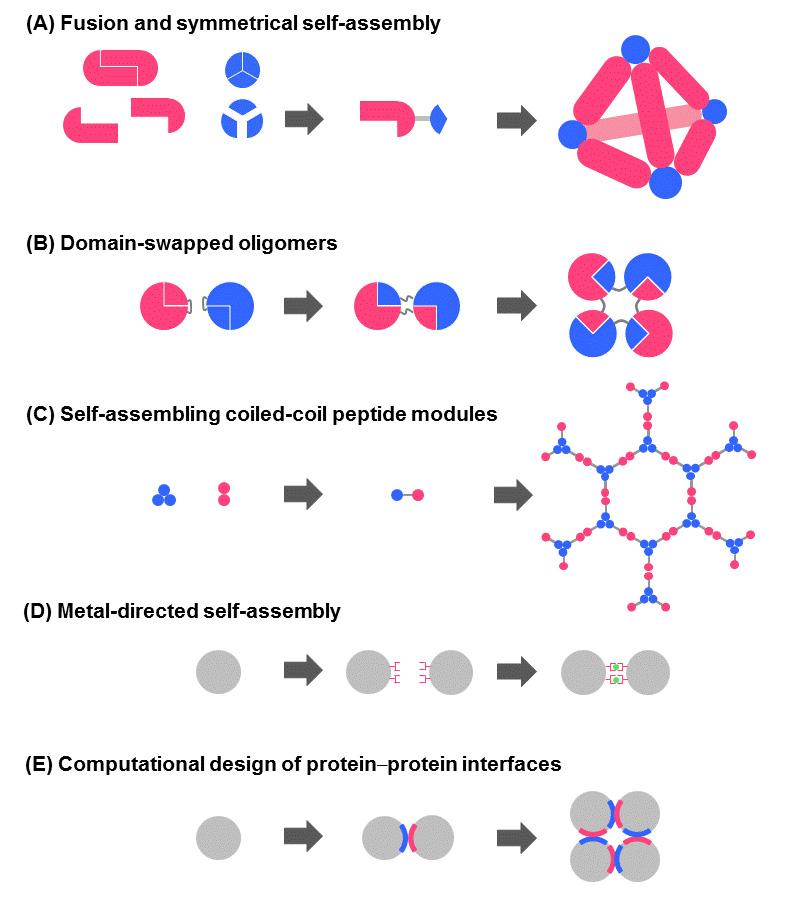
Figure: Design and construction strategies for self-assembling protein complexes using artificial and fusion proteins as nanoscale building blocks. Reprinted from this article, Copyright (2017), with permission from Elsevier.
Associate Professor Ryoichi Arai (Institute of Textile Science and Technology, School of Science and Technology, Academic Assembly / Research Center for Fungal and Microbial Dynamism (CFMD), Department Head of Supramolecular Complexes) and Mr. Naoya Kobayashi (Associate Researcher) published a review article on the recent progress and latest developments in global research on the "design and construction of self-assembling supramolecular protein complexes using artificial and fusion proteins as nanoscale building blocks." This article was published online on February 1, 2017 in Current Opinion in Biotechnology*1 , an international journal published by Elsevier in Holland.
One of the main objectives of nanobiotechnology is to design and construct new nanoscale biomaterials, in this review article, the authors focused on biotechnological research strategies that use artificial and fusion proteins as nanoscale building blocks to design and construct self-assembling supramolecular protein complexes, giving an easy to understand overview of the state of progress of and latest developments in global cutting edge research in this field.
For example, in regard to a wide range of the latest research on the design and construction of supramolecular protein complexes using artificial proteins as nanoscale building blocks, the paper provides a systematic classification of research strategies into the following kinds of categories:
(1) Self-assembly of fusion proteins through symmetrical domains (including a Protein Nanobuilding Block (PN-Block) strategy developed in Arai laboratory);
(2) Multimerization of proteins through domain swapping;
(3) Self-assembly through coiled coil peptides;
(4) Self-assembly of engineered proteins through metal ion coordination; and
(5) Computational design of protein-protein interfaces. As one of the world's foremost experts in this field, Associate Professor Arai has provided an easy to understand overview of the latest global trends and prospects in this research area.
In the future, these diverse strategies for cutting edge bionanotechnology to design and construct supramolecular protein complexes using artificial proteins are expected to further accelerate the development of new functional nanobiomaterials.
This research was supported by JSPS Grant-in-Aids for Scientific Research (JP24113707, JP24780097, JP14J10185, JP16H00761, JP16K05841, JP16H06837) and JSPS Research Fellowships (DC2).
<Explanation of terminology>
*1 Current Opinion in Biotechnology: A first rate peer-reviewed journal published in English by Elsevier in Holland (Impact factor = 8.314, a top 10% ranking journal in the fields of Biotechnology & Applied Microbiology and Biochemical Research Methods). This journal showcases review articles on the latest international research developments and progress in the field of biotechnology in clear and readable forms, with contributions from selected researchers and experts around the world.
<Bibliographic information>
Title: "Design and construction of self-assembling supramolecular protein complexes using artificial and fusion proteins as nanoscale building blocks"
Author: Naoya Kobayashi and Ryoichi Arai* (*Corresponding author)
Journal: Current Opinion in Biotechnology, vol. 46, pp. 57-65, 2017.
DOI : 10.1016/j.copbio.2017.01.001 (Free download link for paper, available until 3/23/2017: https://authors.elsevier.com/a/1UUKm3PtAUheKJ)
<References>
Kobayashi N, Yanase K, Sato T, Unzai S, Hecht MH, Arai R.
Self-Assembling Nano-Architectures Created from a Protein Nano-Building Block Using an Intermolecularly Folded Dimeric de Novo Protein.
Journal of the American Chemical Society, 137(35):11285-11293. 2015.
DOI: 10.1021/jacs.5b03593
Related website: http://www.shinshu-u.ac.jp/institution/iccer/english/topics/iccer/self-assembling-nano-architect.html










